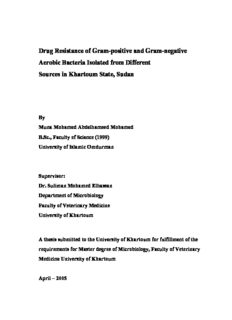
Drug Resistance of Gram-positive and Gram-negative Aerobic Bacteria Isolated from Different ... PDF
Preview Drug Resistance of Gram-positive and Gram-negative Aerobic Bacteria Isolated from Different ...
Drug Resistance of Gram-positive and Gram-negative Aerobic Bacteria Isolated from Different Sources in Khartoum State, Sudan By Muna Mohamed Abdelhameed Mohamed B.Sc., Faculty of Science (1999) University of Islamic Omdurman Supervisor: Dr. Suliman Mohamed Elhassan Department of Microbiology Faculty of Veterinary Medicine University of Khartoum A thesis submitted to the University of Khartoum for fulfillment of the requirements for Master degree of Microbiology, Faculty of Veterinary Medicine University of Khartoum April – 2005 ﻢﻴﺣﺮﻟا ﻦﲪﺮﻟا ﷲا ﻢﺴﺑ ﻲﻟﺎﻌﺗ لﺎﻗ : ﻼً ﻴﻠِﻗَ ﻻﱠ إِ ﻢِ ﻠْﻌِ ﻟْا ﻦﻣﱢ ﻢﺘُﻴﺗِوأُ ﺎﻣَ وَ } { ﻢﻴﻈﻌﻟا ﷲا قﺪﺻ PREFACE This work was carried out at the Department of Microbiology, Faculty of Veterinary Medicine, University of Khartoum under the supervision and guidance of Dr. Suliman Mohamed ElHassan. DEDICATION To the soul of my father. To candle that burn to light for us, my dear mother. To my small family dear husband Dr. ElSheikh and lovely daughter Shahd. To my dear teacher professor Sulieman Mohamed ElSanousi To my brothers and sisters. With love and respect `âÇt ACKNOWLEDGEMENT Above of all my thanks and praise is due to Almighty Allah who gave me patience to accomplish this work. Then I wish to express my appreciation, indebtedness and sincere thankfulness to my supervisor Dr. Suliman Mohamed ElHassan for his advice, encouragement, constructive criticism and valuable assistance. All my kind regards and thanks to my teacher professor Sulieman Mohamed ElSanousi for his encouragement, gentleness, attention and unlimited help. I am grateful to my dear husband Dr. ElSheikh for his encouragement and unlimited assistance during the period of this study. Special thanks and all my love to my lovely daughter Shahd. I wish to express my thanks to Dr. Kamal. H. Ali, Dr. Ahmed Zaki and Dr. Khalid Sulieman for their help. Special thanks and gratitude are due to the staff of Institute for promotion of animal export. Thanks are also extended to the staff of the department of microbiology including head department, technicians and laborers for their cooperation and assistance with special thanks regards and respect to Ustaz. Abd ElAziz Mohamed ElSheikh for his generous help. I would to express my thanks and sincere gratitude to my colleague Nazik ElTayeb. No body has been involved more closely than my affectionate dear mother Saadat Salih and admirable dear brother Yassir Sokrab. I thank them for their encouragement, attention, generosity, sincerity and unlimited help. LIST OF CONTENTS Page Preface i …………………………………….………………………………………………… Dedication………………………………………………………………………………….. ii Acknowledgement ………………………….…………………………………………… iii List of Contents ………………………..………………………………………………… v List of Tables………………………………….…………………………………………… ix List of Figures x …………………………..………………………………………………… English abstract xvi …………………………………………………………………………... Arabic abstract xvii …………………..………..…………………………………..…………… INTRODUCTION………...……………………………..…………………………… xix 1. CHAPTER ONE: LITERATURE REVIEW…….…………………… 1 1.1 Antibiotics 1 1.1.1 Definition and characteristics 1 1.1.2 History and discovery of antibiotics 1 1.1.3 Classification and mechanism of action 3 1.1.3.1 Nucleic acid inhibitors 4 1.1.3.2 Protein synthesis inhibitors 5 1.1.3.3 Cell wall synthesis inhibitors 6 1.1.3.4 Cell membrane function inhibitors 8 1.1.4 Toxicity and side effects 8 1.1.5 Antibiotics spectrum 9 1.1.5.1 Broad spectrum antibiotics 9 1.1.5.2 Narrow spectrum antibiotics 9 1.1.6 Type of action 9 1.1.7 Clinical use of antibiotics 10 1.1.8 Combination of antibiotics 11 1.2 Drug Resistance 11 1.2.1 Multiple-drug Resistance 14 1.2.2 Mechanisms of antibiotics resistance 15 1.2.2.1 Biologic vs. clinical resistance 16 1.2.2.2 Environmentally mediated antimicrobial resistance 16 1.2.2.3 Microorganism- mediated antimicrobial resistance 17 1.2.2.3.1 Intrinsic resistance 17 1.2.2.3.2 Acquired resistance 17 1.2.3 Common pathways for antimicrobial resistance 18 1.2.3.1 Resistance to beta-lactam antibiotics 19 1.2.3.2 Resistance to glycopeptides 20 1.2.3.3 Resistance to aminoglycosides 21 1.2.3.4 Resistance to tetracyclines 22 1.2.3.5 Resistance to quinolones 22 1.2.4 Emergence and dissemination of antimicrobial resistance 22 1.3 Mutation 24 1.3.1 Factors affecting mutation rate 25 1.3.2 Transformation 26 1.3.3 Transduction 27 1.3.4 Conjugation 28 1.3.5 Plasmids 28 1.3.5.1 Resistance plasmids 29 2. CHAPTER TWO: MATERIALS AND METHODS 31 2.1 Sterilization 31 2.1.1 Sterilization of equipments 31 2.1.2 Sterilization of culture media and solution 31 2.2 Reagents 31 2.2.1 Hydrogen peroxide 31 2.2.2 Tetramethyl-p-phenylenediamine dihydrochloride 32 2.2.3 Alpha-naphthol solution 32 2.2.4 Potassium hydroxide 32 2.2.5 Methyl red 32 2.2.6 Nitrate test reagent 32 2.2.7 Kovac's reagent 33 2.3 Indicators 33 2.3.1 Andrade's indicator 33 2.3.2 Phenol red 33 2.3.3 Neutral red 33 2.3.4 Bromothymol blue 34 2.4 Blood 34 2.5 Media 34 2.5.1 Solid media 34 2.5.1.1 Nutrient agar medium 34 2.5.1.2 Blood agar medium 35 2.5.1.3 MacConkey's agar medium 35 2.5.1.4 Diagnostic Sensitivity Test agar (DST) medium 36 2.5.1.5 Urea agar medium 36 2.5.1.6 Aesculin-bile agar medium 37 2.5.1.7 Simmon's citrate medium 37 2.5.1.8 Gelatin medium 37 2.5.2 Semi-solid media 38 2.5.2.1 Hugh and Leifson’s (O-F) medium 38 2.5.2.2 Motility medium 38 2.5.3 Liquid media 39 2.5.3.1 Nutrient broth 39 2.5.3.2 Peptone water 39 2.5.3.3 Peptone water sugar 39 2.5.3.4 Nitrate broth 40 2.5.3.5 Glucose-phosphate medium (MR-VP test medium) 40 2.6 Samples collection 41 2.7 Cultural method 41 2.7.1 Incubation of cultures 41 2.7.2 Examination of cultures 41 2.7.3 Pure culture 42 2.8 Identification of isolated bacteria 42 2.8.1 Primary identification 42 2.8.1.1 Preparation of smears 42 2.8.1.2 Gram's staining method 42 2.8.1.3 Catalase test 43 2.8.1.4 Oxidase test 43 2.8.1.5 Motility 43 2.8.1.6 Oxidation-Fermentation (O-F) test 44 2.8.2 Secondary identification of bacteria 44 2.8.2.1 Sugar fermentation test 44 2.8.2.2 Urease test 45 2.8.2.3 Coagulase test 45 2.8.2.3.1 Slide coagulase test 45
Description: